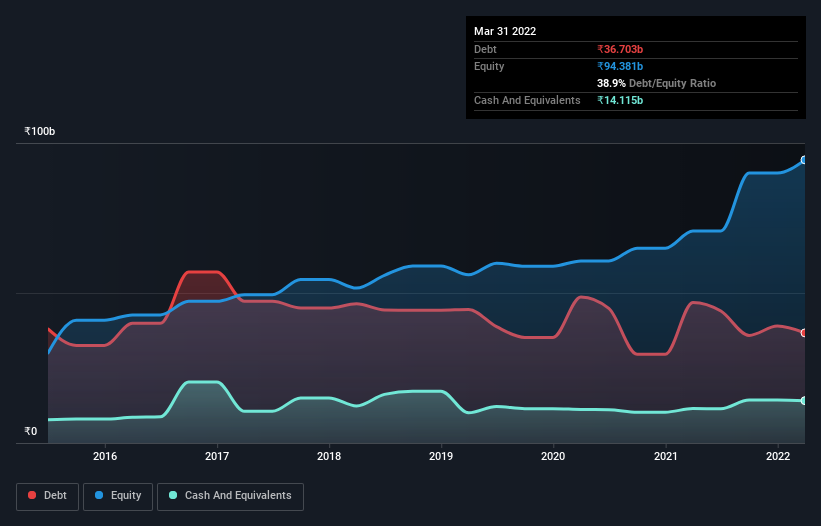We Think Glenmark Pharmaceuticals (NSE:GLENMARK) Can Stay On Top Of Its Debt

The external fund manager backed by Berkshire Hathaway's Charlie Munger, Li Lu, makes no bones about it when he says 'The biggest investment risk is not the volatility of prices, but whether you will suffer a permanent loss of capital.' It's only natural to consider a company's balance sheet when you examine how risky it is, since debt is often involved when a business collapses. We note that Glenmark Pharmaceuticals Limited (NSE:GLENMARK) does have debt on its balance sheet. But is this debt a concern to shareholders?
When Is Debt A Problem?
Debt is a tool to help businesses grow, but if a business is incapable of paying off its lenders, then it exists at their mercy. In the worst case scenario, a company can go bankrupt if it cannot pay its creditors. While that is not too common, we often do see indebted companies permanently diluting shareholders because lenders force them to raise capital at a distressed price. Having said that, the most common situation is where a company manages its debt reasonably well - and to its own advantage. The first step when considering a company's debt levels is to consider its cash and debt together.
View our latest analysis for Glenmark Pharmaceuticals
What Is Glenmark Pharmaceuticals's Net Debt?
The image below, which you can click on for greater detail, shows that Glenmark Pharmaceuticals had debt of ₹36.7b at the end of March 2022, a reduction from ₹46.9b over a year. However, it also had ₹14.1b in cash, and so its net debt is ₹22.6b.

How Strong Is Glenmark Pharmaceuticals' Balance Sheet?
The latest balance sheet data shows that Glenmark Pharmaceuticals had liabilities of ₹46.9b due within a year, and liabilities of ₹29.6b falling due after that. Offsetting these obligations, it had cash of ₹14.1b as well as receivables valued at ₹31.0b due within 12 months. So its liabilities outweigh the sum of its cash and (near-term) receivables by ₹31.3b.
This deficit isn't so bad because Glenmark Pharmaceuticals is worth ₹102.3b, and thus could probably raise enough capital to shore up its balance sheet, if the need arose. However, it is still worthwhile taking a close look at its ability to pay off debt.
We measure a company's debt load relative to its earnings power by looking at its net debt divided by its earnings before interest, tax, depreciation, and amortization (EBITDA) and by calculating how easily its earnings before interest and tax (EBIT) cover its interest expense (interest cover). This way, we consider both the absolute quantum of the debt, as well as the interest rates paid on it.
While Glenmark Pharmaceuticals's low debt to EBITDA ratio of 0.91 suggests only modest use of debt, the fact that EBIT only covered the interest expense by 6.7 times last year does give us pause. But the interest payments are certainly sufficient to have us thinking about how affordable its debt is. Also good is that Glenmark Pharmaceuticals grew its EBIT at 13% over the last year, further increasing its ability to manage debt. There's no doubt that we learn most about debt from the balance sheet. But ultimately the future profitability of the business will decide if Glenmark Pharmaceuticals can strengthen its balance sheet over time. So if you're focused on the future you can check out this free report showing analyst profit forecasts.
Finally, a company can only pay off debt with cold hard cash, not accounting profits. So we always check how much of that EBIT is translated into free cash flow. Looking at the most recent three years, Glenmark Pharmaceuticals recorded free cash flow of 22% of its EBIT, which is weaker than we'd expect. That weak cash conversion makes it more difficult to handle indebtedness.
Our View
Glenmark Pharmaceuticals's net debt to EBITDA was a real positive on this analysis, as was its EBIT growth rate. On the other hand, its conversion of EBIT to free cash flow makes us a little less comfortable about its debt. Looking at all this data makes us feel a little cautious about Glenmark Pharmaceuticals's debt levels. While we appreciate debt can enhance returns on equity, we'd suggest that shareholders keep close watch on its debt levels, lest they increase. The balance sheet is clearly the area to focus on when you are analysing debt. But ultimately, every company can contain risks that exist outside of the balance sheet. To that end, you should be aware of the 1 warning sign we've spotted with Glenmark Pharmaceuticals .
If, after all that, you're more interested in a fast growing company with a rock-solid balance sheet, then check out our list of net cash growth stocks without delay.
New: Manage All Your Stock Portfolios in One Place
We've created the ultimate portfolio companion for stock investors, and it's free.
• Connect an unlimited number of Portfolios and see your total in one currency
• Be alerted to new Warning Signs or Risks via email or mobile
• Track the Fair Value of your stocks
Have feedback on this article? Concerned about the content? Get in touch with us directly. Alternatively, email editorial-team (at) simplywallst.com.
This article by Simply Wall St is general in nature. We provide commentary based on historical data and analyst forecasts only using an unbiased methodology and our articles are not intended to be financial advice. It does not constitute a recommendation to buy or sell any stock, and does not take account of your objectives, or your financial situation. We aim to bring you long-term focused analysis driven by fundamental data. Note that our analysis may not factor in the latest price-sensitive company announcements or qualitative material. Simply Wall St has no position in any stocks mentioned.
About NSEI:GLENMARK
Glenmark Pharmaceuticals
Develops, manufactures, and sells generics, specialty products, and OTC pharmaceutical products in India, North America, Latin America, Europe, and internationally.
Excellent balance sheet and fair value.
Similar Companies
Market Insights
Community Narratives



